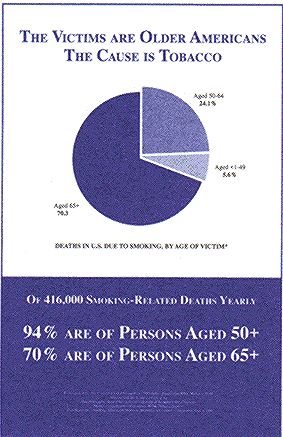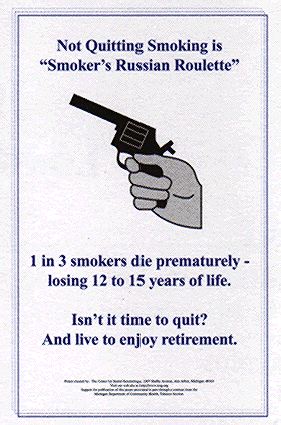Older Americans are the forgotten victims of tobacco-related death and disease. While enormous attention has been focused on tobacco industry marketing to youth -- and rightly so -- the suffering of older persons from tobacco-related diseases has received virtually no attention by the media, researchers, service providers or policymakers.

Comments such as, "someone who has smoked for 50 years can't or won't change," or, "why bother trying to get them to quit, they won't live much longer," indicate that ageism is part of the reason that older smokers have been ignored and neglected. Whether ageism is the cause of the lack of attention to older smokers and older victims of second-hand smoke or whether there are other reasons, the time has come for these attitudes to change.
Yet, many Americans are unaware of both the growth of the aging population and the enormous toll that tobacco-related diseases take on older persons. To begin to remedy this void of information, The Center for Social Gerontology (TCSG), with support from the Michigan Department of Community Health, has embarked on a campaign to raise the consciousness of people of all ages about the impact of tobacco-related diseases on older Americans.
The dissemination of TCSG's Tobacco & the Elderly Notes newsletter and other publications has begun to focus attention on this issue. TCSG's web site at http://www.tcsg.org includes a special section on Tobacco & the Elderly issues, including copies of our newsletter, to provide easy and broad access to this information.

Now, TCSG has created and is disseminating two posters for posting at Senior Centers, meals sites for the elderly, health centers, meeting facilities, recreation centers, housing facilities for elders, educational facilities, and other facilities serving old and young.
These posters highlight two basic themes: first, older Americans are the ones who suffer from the disease and death caused by tobacco use; and second, not quitting smoking can shorten a persons life by 12 to 15 years, thereby eliminating any retirement years. The message of these posters is that older Americans must be included in any efforts to reduce tobacco use, to create smoke-free environments and to remedy the health damage caused by tobacco use. For more information on the posters (and bigger pictures of the posters themselves), click here.
 the cancerous lump, followed by two
courses of radiation
therapy. In January and May of 1998 he was tested and found to be free of
any further cancer.
the cancerous lump, followed by two
courses of radiation
therapy. In January and May of 1998 he was tested and found to be free of
any further cancer.
 Today's older Americans --
those persons aged 50 and over -- were born before 1948. Their most
formative years were during the period leading up to their early twenties,
that is, the 1930s to the early 1970s. This was the period when tobacco
advertising also had its strongest effect, since research has shown that
90% of current smokers started when they were under 18 years of age.
Today's older Americans --
those persons aged 50 and over -- were born before 1948. Their most
formative years were during the period leading up to their early twenties,
that is, the 1930s to the early 1970s. This was the period when tobacco
advertising also had its strongest effect, since research has shown that
90% of current smokers started when they were under 18 years of age. sports, movie, radio, TV and
other celebrities to glorify smoking and chewing to attract new
generations of smokers to replace those who quit or die. Since the 1930s,
athletes have been among the most prominent celebrities hired to promote
tobacco products.
sports, movie, radio, TV and
other celebrities to glorify smoking and chewing to attract new
generations of smokers to replace those who quit or die. Since the 1930s,
athletes have been among the most prominent celebrities hired to promote
tobacco products.